Protected Areas: Geotourist Attractiveness for Weekend Tourists Based on the Example of Gorczański National Park in Poland
Abstract
1. Introduction
2. Study Area
2.1. Gorczański National Park Location
2.2. Tourist Attractiveness of Gorczański National Park
- they are big enough to be recognizable in the landscape;
- they arouse interest among tourists;
- they are inherently resistant to tourist traffic in their immediate vicinity;
- they are properly adapted to the reception of tourist traffic [67].
- Values that are not influenced by human activity. These are caves and grottoes, groups of rocks, valleys and gullies, erratics, scenic viewpoints presenting geologically and geomorphologically attractive landscapes, and among the elements of an animated nature—peculiarities of fauna and flora.
- Values whose character and shape have been significantly influenced by human activity. This group includes primarily assets of an animated nature, such as historic parks, botanical, and zoological gardens.
- Values of surface character. Human activity did not affect their nature or shape. These are protected areas that constitute a reservoir of many assets of an animated and inanimate nature, protected because of their unique character. In this group, the most important type is national parks, which in Poland have the status of the highest form of nature conservation.
2.3. Geology of Gorczański National Park
2.4. Geotourist Values of the Gorce Mts
2.5. Other Natural Sightseeing Values (Figure 3)
2.6. Accompanying Infrastructure
2.7. Hiking, Bike, and Horse Tourist Trails
2.8. Didactic Routes
2.9. Tourist Traffic in Gorczański National Park
2.10. Threats to the Inanimate Nature Resulting from the Tourist Traffic in Gorczański National Park
- existing internal threats;
- potential internal threats;
- existing external threats;
- potential external threats.
3. Materials and Methods
4. Results and Discussion
4.1. The Tourist Attractiveness of Gorczański National Park from the Opinion of Tourists
4.1.1. Tourist Profile
4.1.2. Region of Origin of the Respondents
4.1.3. Purpose of a Visit to Gorczański National Park
4.1.4. Evaluation of Trails and Educational Offer of Gorczański National Park
4.1.5. Didactic Routes in the Opinion of Tourists
4.1.6. General Assessment of Gorczański National Park
5. Conclusions
Author Contributions
Funding
Acknowledgments
Conflicts of Interest
References
- Russell, M.A.; Bradford, J.E.; Murphy, L.E.E.C. Waters and development of a turn-of-the-century tourist economy in Yellowstone National Park. Hist. Archeol. 2004, 38, 96–113. [Google Scholar] [CrossRef]
- Hunt, W.J., Jr. A Model of Tourism as Context for Historical Sites: An Example of Historical Archeology at Yellowstone National Park. In Historical Archeology of Tourism in Yellowstone National Park; Corbin, A., Russell, M.A., Eds.; Springer: New York, NY, USA, 2010; pp. 1–74. [Google Scholar]
- Bergstrom, R.D.; Harrington, L.M.B. Embedded in nature: Challenges to sustainability in communities of the Greater Yellowstone ecosystem. Sustainability 2019, 11, 1459. [Google Scholar] [CrossRef]
- Bushell, R.; Staiff, R.; Eagles, P.F.J. Tourism and Protected Areas: Benefits beyond Boundaries. In Tourism and Protected Areas: Benefits beyond Boundaries; Bushell, R., Eagles, P.F.J., Eds.; CABI: Wallingford, UK, 2007; pp. 1–11. [Google Scholar]
- Kuenzi, C.; McNeely, J. Nature-Based Tourism. In Global Risk Governance; Renn, O., Walker, K.D., Eds.; IUCN Publishing: Gland, Switzerland, 2008; pp. 155–178. [Google Scholar]
- Balmford, A.; Beresford, J.; Green, J.; Naidoo, R.; Walpole, M.; Manica, A. A global perspective of trends in nature-based tourism. PLoS Biol. 2009, 7, e1000144. [Google Scholar] [CrossRef] [PubMed]
- Buckley, R. Ecotourism: Principles and Practises; CABI: Wallingford, UK, 2009. [Google Scholar]
- Newsome, D.; Moore, S.A.; Dowling, R.K. Natural Area Tourism: Ecology, Impacts and Management, 2nd ed.; Channel View Publications: Bristol, UK, 2013. [Google Scholar]
- Eagles, P.F.J. Research priorities in park tourism. J. Sustain. Tour. 2014, 22, 528–549. [Google Scholar] [CrossRef]
- Garavaglia, V.G.; Diolaiuti, G.; Smiraglia, C.; Pasquale, V.; Pelfini, M. Evaluating tourist perception of environmental changes as a contribution to managing natural resources in glacierized areas: A case study of the Forni Glacier (Stelvio National Park, Italian Alps). Environ. Manag. 2012, 50, 1125–1138. [Google Scholar] [CrossRef] [PubMed]
- Henriques, M.H.; Pena dos Reis, R.; Brilha, J.; Mota, T. Geoconservation as an emerging geoscience. Geoheritage 2011, 3, 117–128. [Google Scholar] [CrossRef]
- Gray, M. Other nature: Geodiversity and geosystem services. Environ. Conserv. 2011, 38, 271–274. [Google Scholar] [CrossRef]
- Burek, C.V.; Prosser, C.D. The history of geoconservation: An introduction. Geol. Soc. Lond. Spec. Publ. 2008, 300, 1–5. [Google Scholar] [CrossRef]
- Gray, M. Geodiversity and Geoconservation: What, Why, and How? In Papers Presented at the George Wright Forum; Santucci, V.L., Ed.; Book Concern Printers: Hancock, MI, USA, 2005; pp. 4–12. [Google Scholar]
- Serrano, E.; González-Trueba, J.J. Assessment of geomorphosites in natural protected areas: The Picos de Europa National Park (Spain). Geomorphol. Relief Process. Environ. 2005, 11, 197–208. [Google Scholar] [CrossRef]
- Lima, F.; Brilha, J.; Salamun, E. Inventorying geological heritage in large territories: A methodological proposal applied to Brazil. Geoheritage 2010, 2, 91–99. [Google Scholar] [CrossRef]
- Fassoulas, C.; Mouriki, D.; Dimitriou-Nikolakis, P.; Iliopoulos, G. Quantitative assessment of geotopes as an effective tool for geoheritage management. Geoheritage 2012, 4, 177–193. [Google Scholar] [CrossRef]
- Božić, S.; Tomić, N. Canyons and gorges as potential geotourism destinations in Serbia: Comparative analysis from two different perspectives—General tourists’ and geotourists’. Open Geosci. 2015, 7, 531–546. [Google Scholar] [CrossRef]
- Dowling, R.K.; Newsome, D. Geotourism: Sustainability, Impacts and Management; Elsevier: Oxford, UK, 2006. [Google Scholar]
- Honey, M. Ecotourism and Sustainable Development: Who Own Paradise? 2nd ed.; Island Press: Washington, DC, USA, 2008. [Google Scholar]
- Hose, T.A. Selling the story of Britain’s stone. Environ. Interpret. 1995, 10, 16–17. [Google Scholar]
- Panizza, M. Geomorphosites: Concepts, methods and example of geomorphological survey. Chin. Sci. Bull. 2001, 46, 4–6. [Google Scholar] [CrossRef]
- Słomka, T.; Kicińska-Świderska, A. Geoturystyka-podstawowe pojęcia. Geoturystyka 2004, 1, 5–7. [Google Scholar]
- Valentine, P.S. Review: Nature-based tourism. In Special Interest Tourism; Weiler, B., Hall, C.M., Eds.; Belhaven Press: London, UK, 1992; pp. 105–127. [Google Scholar]
- Tonge, J.; Moore, S. Importance-satisfaction analysis for marine-park hinterlands: A Western Australian case study. Tour Manag. 2007, 28, 768–776. [Google Scholar] [CrossRef]
- McIntosh, R.W.; Goeldner, C.R.; Ritchie, J.R.B. Tourism: Principles, Practices, Philosophies; Wiley: New York, NY, USA, 1995. [Google Scholar]
- Ceballos-Lascurain, H. Tourism, Ecotourism and Protected Areas: The State of Nature-Based Tourism around the World and Guidelines for Its Development; IUCN: Cambridge, UK, 1996. [Google Scholar]
- Bushell, B. Global issues for protected areas and nature-based tourism: Case studies of partnership in australia addressing some of these issues. In International Workshop: Case Studies on Sustainable Tourism and Biological Diversity; Gunling, L., Korn, H., Specht, R., Eds.; German Federal Agency for Nature Conservation: Bonn, Germany, 1999; pp. 93–114. [Google Scholar]
- Priskin, J. Assessment of natural resources for nature-based tourism: The case of the Central Coast region of Western Australia. Tour Manag. 2001, 22, 637–648. [Google Scholar] [CrossRef]
- Walpole, M.J. Feeding dragons in Komodo National Park: A tourism tool with conservation complications. Anim. Conserv. 2001, 4, 67–73. [Google Scholar] [CrossRef]
- Walpole, M.J.; Goodwin, H.J. Local attitudes towards conservation and tourism around Komodo National Park, Indonesia. Environ. Conserv. 2001, 28, 160–166. [Google Scholar] [CrossRef]
- Guyer, C.; Pollard, J. Cruise visitor impressions of the environment of the Shannon-Erne waterways system. J. Environ. Manag. 1997, 51, 199–215. [Google Scholar] [CrossRef]
- Hose, T.A. Telling the story of stone—Assessing the client base. In Geological and Landscape Conservation; O’Halloran, D., Green, C., Harley, M., Stanley, M., Knill, S., Eds.; Geological Society: London, UK, 1994; pp. 451–457. [Google Scholar]
- Hose, T.A. Geotourism—Selling the earth to europe. In Engineering Geology and the Environment; Marinos, P.G., Koukis, G.C., Tsiambaos, G.C., Stournaras, G.C., Eds.; Balkema: Rotterdam, The Netherlands, 1997; pp. 2955–2960. [Google Scholar]
- Hose, T.A. Is it any fossicking good? Or behind the signs—A critique of current geotourism interpretative media. In Unpublished Paper Delivered to the Tourism in Geological Landscapes Conference; Ulster Museum: Belfast, UK, 1998. [Google Scholar]
- Hose, T.A. European geotourism—Geological interpretation and geoconservation promotion for tourists. In Geological Heritage: Its Conservation and Management; Barretino, D., Wimbledon, W.P., Gallego, E., Eds.; Instituto Tecnologico Geominero de Espana: Madrid, Spain, 2000; pp. 127–146. [Google Scholar]
- Hose, T.A. Towards a history of geotourism: Definitions, antecedents and the future. Geol. Soc. Lond. Spec. Publ. 2008, 300, 37–60. [Google Scholar] [CrossRef]
- Hose, T.A.; Vasiljević, D.A. Defining the nature and purpose of modern geotourism with particular reference to the United Kingdom and South-East Europe. Geoheritage 2012, 4, 25–43. [Google Scholar] [CrossRef]
- Newsome, D.; Dowling, R.K. Geotourism: The Tourism of Geology and Landscape; Goodfellow: Oxford, UK, 2010. [Google Scholar]
- Santangelo, N.; Romano, P.; Santo, A. Geo-itineraries in the Cilento Vallo di Diano Geopark: A tool for tourism development in southern Italy. Geoheritage 2015, 7, 319–335. [Google Scholar] [CrossRef]
- Liddle, M.J. Recreation Ecology: The Ecological Impact of Outdoor Recreation and Ecotourism; Chapman and Hall: London, UK, 1997. [Google Scholar]
- Newsome, D.; Moore, S.A.; Dowling, R.K. Natural Area Tourism: Ecology, Impacts and Management; Channel View Publications: Sydney, Australia, 2002. [Google Scholar]
- Buckley, R. Impacts positive and negative: Links between ecotourism and environment. In Environmental Impacts of Ecotourism; Buckley, R., Ed.; CABI: New York, NY, USA, 2004; pp. 1–14. [Google Scholar]
- Cole, D.N. Impacts of hiking and camping on soils and vegetation: A review. In Environmental Impacts of Ecotourism; Buckley, R., Ed.; CABI: Oxford, UK, 2004; pp. 41–60. [Google Scholar]
- Newsome, D.; Cole, D.N.; Marion, J. Environmental impacts associated with recreational horse-riding. In Environmental Impacts of Ecotourism; Buckley, R., Ed.; CABI: New York, NY, USA, 2004; pp. 61–82. [Google Scholar]
- Kelly, C.L.; Pickering, C.M.; Buckley, R.C. Impacts of tourism on threatened plant taxa and communities in Australia. Ecol. Manag. Restor. 2003, 4, 37–44. [Google Scholar] [CrossRef]
- Pickering, C.M.; Hill, W. Impacts of recreation and tourism on plant biodiversity and vegetation in protected areas in Australia. J. Environ. Manag. 2007, 85, 791–800. [Google Scholar] [CrossRef]
- Ballantyne, M.; Gudes, O.; Pickering, C.M. Visitor trails are an important cause of fragmentation in endangered urban forests. Landsc. Urban Plan. 2014, 130, 112–124. [Google Scholar] [CrossRef]
- Godefroid, S.; Koedam, N. The impact of forest paths upon adjacent vegetation: Effects of the path surfacing material on the species composition and soil compaction. Biol. Conserv. 2004, 119, 405–419. [Google Scholar] [CrossRef]
- Hill, W.; Pickering, C.M. Vegetation associated with different walking track types in the Kosciuszko Alpine area, Australia. J. Environ. Manag. 2006, 78, 24–34. [Google Scholar] [CrossRef]
- Wimpey, J.; Marion, J.L. The influence of use, environmental and managerial factors on the width of recreational trails. J. Environ. Manag. 2010, 91, 2028–2037. [Google Scholar] [CrossRef]
- Kutiel, P.; Zhevelev, H.; Harrison, R. The effect of recreational impacts on soil and vegetation of stabilised Coastal Dunes in the Sharon Park, Israel. Ocean Coast. Manag. 1999, 42, 1041–1060. [Google Scholar] [CrossRef]
- Marion, J.L.; Leung, Y.F. Trail resource impacts and an examination of alternative assessment techniques. J. Park Recreat. Adm. 2001, 19, 17–37. [Google Scholar]
- Monz, C.A.; Cole, D.N.; Leung, Y.F.; Marion, J.L. Sustaining visitor use in protected areas: Future opportunities in recreation ecology research based on the USA experience. Environ. Manag. 2010, 45, 551–562. [Google Scholar] [CrossRef] [PubMed]
- Marion, J.L.; Wimpey, J.F.; Park, L.O. The science of trail surveys: Recreation ecology provides new tools for managing wilderness trails. Park Sci. 2011, 28, 60–65. [Google Scholar]
- Fenu, G.; Cagoni, D.; Ulian, T.; Bacchetta, G. The impact of human trampling on a threatened coastal Mediterranean plant: The case of Anchusa littorea Moris (Boraginaceae). Flora 2013, 208, 104–110. [Google Scholar] [CrossRef]
- McCool, S.F. Constructing partnerships for protected area tourism planning in an era of change and messiness. J. Sustain. Tour. 2009, 17, 133–148. [Google Scholar] [CrossRef]
- Panizza, M.; Piacente, S. Geomorfologia Culturale; Pitagora Editrice: Bologna, Italy, 2003. [Google Scholar]
- Kondracki, J. Geografia Regionalna Polski; PWN: Warszawa, Poland, 2000. [Google Scholar]
- Ordinance of the Council of Ministers of August 8, 1980 on the creation of the Gorczański National Park. Journal of Laws, 22 August 1980.
- Kruczek, Z. Atrakcje Turystyczne. Fenomen, Typologia, Metody Badań; Proksenia: Kraków, Poland, 2011. [Google Scholar]
- Lijewski, T.; Mikułowski, B.; Wyrzykowski, J. Geografia Turystyki Polski; Polskie Wydawnictwo Ekonomiczne: Warszawa, Poland, 1998. [Google Scholar]
- Warszyńska, J.; Jackowski, A. Podstawy Geografii Turyzmu; PWN: Warszawa, Poland, 1978. [Google Scholar]
- Rogalewski, O. Zagospodarowanie Turystyczne; WSiP: Warszawa, Poland, 1979. [Google Scholar]
- Lijewski, T.; Mikułowski, B.; Wyrzykowski, J. Geografia Turystyki Polski; Polskie Wydawnictwo Ekonomiczne: Warszawa, Poland, 2002. [Google Scholar]
- Kowalczyk, A. Geografia Turyzmu; PWN: Warszawa, Poland, 2001. [Google Scholar]
- Lijewski, T.; Mikułowski, B.; Wyrzykowski, J. Geografia Turystyki Polski, 5th ed.; Polskie Wydawnictwo Ekonomiczne: Warszawa, Poland, 2008. [Google Scholar]
- Cieszkowski, M.; Chodyń, R.; Szczęch, M. Gorce—Góry fliszowe. In Gorczański Park Narodowy. Przyroda i Krajobraz Pod Ochroną; Czarnota, P., Stefanik, M., Eds.; Gorczański Park Narodowy: Poręba Wielka, Poland, 2015; pp. 39–51. [Google Scholar]
- Pawlik, Ł.; Šamonil, P.; Malik, I.; Kroh, P.; Ślęzak, A.; Danĕk, P. Geomorphic edge effects in response to abiotic and anthropogenic disturbances in forest ecosystems of the Gorce Mountains, Western Carpathians. Catena 2019, 177, 134–148. [Google Scholar] [CrossRef]
- Andreucci, B.; Castelluccio, A.; Jankowski, L.; Mazzoli, S.; Szaniawski, R.; Zattin, M. Burial and exhumation history of the Polish Outer Carpathians: Discriminating the role of thrusting and post-thrusting extension. Tectonophys 2013, 608, 866–883. [Google Scholar] [CrossRef]
- Gorczański Park Narodowy. Przyroda Nieożywiona. Available online: https://www.gorczanskipark.pl/page,art,id,11,kategoria,Przyroda_nieozywiona.html (accessed on 15 November 2019).
- Cieszkowski, M. Geologiczne walory naukowe Gorczańskiego Parku Narodowego i jego otoczenia. Ochr. Besk. Zach. 2006, 1, 45–57. [Google Scholar]
- Szczęch, M.; Cieszkowski, M.; Chodyń, R.; Loch, J. Geotouristic values of the Gorce National Park and its surroundings (the Outer Carpathians, Poland). Geotourism 2016, 1–2, 27–44. [Google Scholar] [CrossRef]
- Chowaniec, J.; Poprawa, D.; Witek, K. Stop E8—Rabka: Wody mineralne. In Carpatian Paleogeography and Geodynamics: A Multidisciplinary Approach. Field Trip Guide, Proceedings of the 12th Meeting of the Association of European Geological Societies, Kraków, Poland, 10–15 September 2001; Birkenmajer, K., Krobicki, M., Eds.; Państwowy Instytut Geologiczny: Kraków, Poland, 2001; pp. 121–125. [Google Scholar]
- Chowaniec, J.; Poprawa, D.; Witek, K. Występowanie wód termalnych w polskiej części Karpat. Przegl. Geol. 2001, 49, 728–742. [Google Scholar]
- Statistics Poland. Ochrona Środowiska 2018; Statistics Poland: Warsaw, Poland, 2018. [Google Scholar]
- Statistics Poland. Ochrona Środowiska 2011; Statistics Poland: Warsaw, Poland, 2011. [Google Scholar]
- Statistics Poland. Ochrona Środowiska 2012; Statistics Poland: Warsaw, Poland, 2012. [Google Scholar]
- Statistics Poland. Ochrona Środowiska 2013; Statistics Poland: Warsaw, Poland, 2013. [Google Scholar]
- Statistics Poland. Ochrona Środowiska 2014; Statistics Poland: Warsaw, Poland, 2014. [Google Scholar]
- Statistics Poland. Ochrona Środowiska 2015; Statistics Poland: Warsaw, Poland, 2015. [Google Scholar]
- Statistics Poland. Ochrona Środowiska 2016; Statistics Poland: Warsaw, Poland, 2016. [Google Scholar]
- Statistics Poland. Ochrona Środowiska 2017; Statistics Poland: Warsaw, Poland, 2017. [Google Scholar]
- Kruczek, Z. Frekwencja w polskich atrakcjach turystycznych. Problemy oceny liczby odwiedzających. Ekon. Probl. Turyst. 2016, 3, 25–35. [Google Scholar] [CrossRef][Green Version]
- Partyka, J. Ruch turystyczny w polskich parkach narodowych. Folia Turist. 2010, 22, 9–23. [Google Scholar]
- Baraniec, A. Turystyka w Babiogórskim Parku Narodowym. In Użytkowanie Turystyczne Parków Narodowych; Partyka, J., Ed.; Wydawnictwo Ojcowski Park Narodowy: Ojców, Poland, 2002; pp. 155–165. [Google Scholar]
- Wieniawska, B. Turystyka a ochrona przyrody w Karkonoskim Parku Narodowym. In Użytkowanie Turystyczne Parków Narodowych; Partyka, J., Ed.; Wydawnictwo Ojcowski Park Narodowy: Ojców, Poland, 2002; pp. 259–270. [Google Scholar]
- Fidelus, J. Turystyka piesza i jej wpływ na przemiany rzeźby terenu w otoczeniu hal Gąsienicowej i Kondratowej w Tatrach. In Stan i Perspektywy Rozwoju Turystyki w Tatrzańskim Parku Narodowym; Pociask-Karteczka, J., Matuszyk, A., Skawiński, P., Eds.; AWF: Kraków, Poland, 2007; pp. 261–272. [Google Scholar]
- Act of April 16, 2004 on nature conservation. Journal of Laws, No. 92, Item 880, Art. 5. Available online: http://prawo.sejm.gov.pl/isap.nsf/DocDetails.xsp?id=WDU20040920880 (accessed on 10 December 2019).
- Conservation Plan for Gorczański National Park of 2018. Available online: https://www.gorczanskipark.pl/UserFiles/File/2018/BIP%20i%20ogloszenia/PROJEKT%20%20z%2015-01-2018%20Planu%20Ochrony%20GPN.pdf (accessed on 27 November 2019).
- Beerli, A.; Martín, D. Tourists characteristics and the perceived image of tourists destination: A quantitative analysis of a case study of Lanzarote, Spain. Tour Manag. 2004, 25, 623–636. [Google Scholar] [CrossRef]
- Togridou, A.; Hovardas, T.; Pantis, J.D. Determinants of visitors willingness to pay for the National Marine Park of Zakynthos, Greece. Ecol. Econ. 2006, 60, 308–319. [Google Scholar] [CrossRef]
- Ceurvorst, R.; Lamborn, C. Visitor attitudes and value orientations for a proposed national monument. J. Outdoor Recreat. Tour. 2018, 23, 33–43. [Google Scholar] [CrossRef]
- Mmopelwa, G.; Kgathi, D.L.; Molefhe, L. Tourists’ perceptions and their willingness to pay for park fees: A case study of self-drive tourists and clients for mobile tour operators in Moremi Game Reserve, Botswana. Tour Manag. 2007, 28, 1044–1056. [Google Scholar] [CrossRef]
- Jones, N.; Panagiotidou, K.; Spilanis, I.; Evangelinos, K.; Dimitrakopoulos, P. Visitors’ perceptions on the management of an important nesting site for loggerhead sea turtle (Caretta caretta L.): The case of Rethymno coastal area in Greece. Ocean Coast. Manag. 2011, 54, 577–584. [Google Scholar] [CrossRef]
- Lili, P.; Lijuan, C.; Ming, W. Tourist behaviors in Wetland Park: A preliminary study in Xixi National Wetland Park, Hangzhou, China. Chin. Geogr. Sci. 2010, 20, 66–73. [Google Scholar]
- Beh, A.; Bruyere, B. Segmentation by visitor motivation in three Kenyan national reserves. Tour Manag. 2007, 28, 1464–1471. [Google Scholar] [CrossRef]
- Ehrenfeld, D. The conservation of non-resources. Am. Sci. 1976, 64, 648–656. [Google Scholar]
- Ferreira, S.; Harmse, A. Kruger National Park: Tourism development and issues around the management of large numbers of tourists. J. Ecotour. 2014, 13, 16–34. [Google Scholar] [CrossRef]
- Adams, C.; Seroa da Motta, R.; Ortiz, A.; Reid, J.; Aznar, E.; Sinisgalli, A. The use of contingent valuation for evaluating protected areas in the developing world: Economic valuation of Morro do Diabo State Park, Atlantic Rainforest, São Paolo State (Brazil). Ecol. Econ. 2008, 66, 359–370. [Google Scholar] [CrossRef]
- Duzgunes, E.; Demirel, O. Determining the tourism potential of the Altindere Valley National Park (Trabzon/Turkey) with respect to its conservation value. Int. J. Sustain. Dev. World Ecol. 2013, 20, 358–368. [Google Scholar] [CrossRef]
- Mayer, M. Can nature-based tourism benefits compensate for the costs of national parks? A study of the Bavarian Forest National Park, Germany. J. Sustain. Tour. 2014, 22, 561–583. [Google Scholar] [CrossRef]
- Reimann, M.; Lamp, M.-L.; Palang, H. Tourism impacts and local communities in Estonian National Parks. Scand. J. Hosp. Tour. 2011, 11, 87–99. [Google Scholar] [CrossRef]
- Strickland-Munro, J.; Moore, S. Indigenous involvement and benefits from tourism in protected areas: A study of Purnululu National Park and Warmun Community, Australia. J. Sustain. Tour. 2013, 21, 26–41. [Google Scholar] [CrossRef]
- Muller, M.; Job, H. Managing natural disturbance in protected areas: Tourists’ attitude towards the bark beetle in a German national park. Biol. Conserv. 2009, 142, 375–383. [Google Scholar] [CrossRef]
- Oh, C.O.; Draper, J.; Dixon, A.W. Comparing resident and tourist preferences for public beach access and related amenities. Ocean Coast. Manag. 2010, 53, 245–251. [Google Scholar] [CrossRef]
- Peters, H.; Hawkins, J.P. Access to marine parks: A comparative study in willingness to pay. Ocean Coast. Manag. 2009, 52, 219–228. [Google Scholar] [CrossRef]
- Petrosillo, I.; Zurlini, G.; Corliano, M.E.; Zacarrelli, E.; Dadamo, M. Tourist perception of recreational environment and management in a marine protected area. Landsc. Urban Plan. 2007, 79, 29–37. [Google Scholar] [CrossRef]
- Buultjens, J.; Ratnayake, I.; Gnanapala, A.; Aslam, M. Tourism and its implications for management in Ruhuna National Park (Yala), Sri Lanka. Tour Manag. 2005, 26, 733–742. [Google Scholar] [CrossRef]
- Cunha, A.A. Negative effects of tourism in a Brazilian Atlantic forest National Park. J. Nat. Conserv. 2010, 18, 291–295. [Google Scholar] [CrossRef]
- Haukeland, J.V.; Grue, B.; Veisten, K. Turning national parks into tourism attractions: Nature orientation and quest for facilities. Scand. J. Hosp. Tour. 2010, 10, 248–271. [Google Scholar] [CrossRef]
- Fleishman, L.; Feitelson, E.; Salomon, I. The role of cultural and demographic diversity in crowding perception: Evidence from nature reserves in Israel. Tour. Anal. 2004, 9, 23–40. [Google Scholar] [CrossRef]
- Oku, H.; Fukamachi, K. The differences in scenic perception of forest visitors through their attributes and recreational activity. Landsc. Urban Plan. 2006, 75, 34–42. [Google Scholar] [CrossRef]
- Arnberger, A.; Brandenburg, C. Past on-site experience, crowding perceptions, and use displacement of visitor groups to a periurban national park. Environ. Manag. 2007, 40, 34–45. [Google Scholar] [CrossRef]
- Arnberger, A.; Haider, W. A comparison of global and actual measures of perceived crowding of urban forest visitors. J. Leis. Res. 2007, 39, 668–685. [Google Scholar] [CrossRef]
- Leujak, W.; Ormond, R.F.G. Visitor perceptions and the shifting social carrying capacity of south Sinai’s coral reefs. Environ. Plan. 2007, 39, 472–489. [Google Scholar] [CrossRef]
- Uysal, M.; Jurowski, C.; Noe, F.P.; McDonald, C.D. Environmental attitude by trip and visitor characteristics—US Virgin Islands National Park. Tour Manag. 1994, 15, 284–294. [Google Scholar] [CrossRef]
- Puhakka, R. Environmental concern and responsibility among nature tourists in Oulanka PAN Park, Finland. Scand. J. Hosp. Tour. 2011, 11, 76–96. [Google Scholar] [CrossRef]
- Dunlap, R.E.; Van Liere, K.D.; Mertig, A.G.; Jones, R.E. Measuring endorsement of the new ecological paradigm: A revised NEP scale. J. Soc. Issues 2000, 56, 425–442. [Google Scholar] [CrossRef]
- Akama, J.S.; Land, C.L.; Burnett, G.W. Conflicting attitudes toward state wildlife conservation programs in Kenya. Soc. Nat. Resour. 1995, 8, 133–144. [Google Scholar] [CrossRef]
- Infield, M. Attitudes of rural communities towards conservation and local conservation areas in Natal, South Africa. Biol. Conserv. 1988, 45, 21–46. [Google Scholar] [CrossRef]
- Newmark, W.D.; Leonard, N.L.; Sariko, H.I.; Gamassa, D.M. Conservation attitudes of local people living adjacent to five protected areas in Tanzania. Biol. Conserv. 1993, 63, 177–183. [Google Scholar] [CrossRef]
- Trakolis, D. Local people’s perceptions of planning and management issues in Prespes Lakes National Park, Greece. J. Environ. Manag. 2001, 61, 227–241. [Google Scholar] [CrossRef]
- Hall, T.; Shelby, B. Temporal and spatial displacement: Evidence from a high-use reservoir and alternative sites. J. Leis. Res. 2000, 32, 435–456. [Google Scholar] [CrossRef]
- Manning, R.E.; Valliere, W.A. Coping in outdoor recreation: Causes and consequences of crowding and conflict among community residents. J. Leis. Res. 2001, 33, 410–426. [Google Scholar] [CrossRef]
- Balmford, A.; Green, J.M.H.; Anderson, M.; Beresford, J.; Huang, C.; Naidoo, R.; Manica, A. Walk on the wild side: Estimating the global magnitude of visits to protected areas. PLoS Biol. 2015, 13, e1002074. [Google Scholar] [CrossRef]
- Kretchaman, J.; Eagles, P. An analysis of the motives of ecotourists in comparison to the general Canadian population. Soc. Leis. 1990, 13, 499–508. [Google Scholar] [CrossRef]
- Eagles, P.F. The travel motivations of Canadian ecotourists. J. Travel Res. 1992, 31, 3–7. [Google Scholar] [CrossRef]
- Wright, P.A. North American ecotourism markets: Motivations, preferences, and destinations. J. Travel Res. 1996, 35, 3–10. [Google Scholar]
- Palacio, V.; McCool, S.F. Identifying ecotourists in Belize through benefit segmentation: A preliminary analysis. J. Sustain. Tour. 1997, 5, 234–243. [Google Scholar] [CrossRef]
- Chan, J.K.L.; Baum, T. Motivation factors of ecotourists in ecolodge accommodation: The push and pull factors. Asia Pac. J. Tour. Res. 2007, 12, 349–364. [Google Scholar] [CrossRef]
- Dodds, R.; Graci, S.R.; Holmes, M. Does the tourist care? A comparison of tourists in Koh Phi Phi, Thailand and Gili Trawangan, Indonesia. J. Sustain. Tourism. 2010, 18, 207–222. [Google Scholar] [CrossRef]
- Butler, R.; Boyd, S. (Eds.) Tourism and National Parks: Issues and Implications; Wiley: Chichester, UK, 2000. [Google Scholar]
- McCool, S.F. Managing for visitor experiences in protected areas: Promising opportunities and fundamental challenges. PARKS Int. J. Prot. Areas Manag. 2006, 16, 3–9. [Google Scholar]
- Arabatzis, G.; Grigoroudis, E. Visitors’ satisfaction, perceptions and gap analysis: The case of Dadia-Lefkimi-Souflion National Park. Landsc. Urban Plan. 2010, 97, 229–238. [Google Scholar] [CrossRef]
- Suckall, N.; Fraser, E.D.G.; Cooper, T.; Claire, Q. Visitor perceptions of rural landscapes: A case study in the Peak District National Park, England. J. Environ. Manag. 2009, 90, 1195–1203. [Google Scholar] [CrossRef]
- Andersson, T.D. The tourist in the experience economy. Scand. J. Hosp. Tour. 2007, 7, 46–58. [Google Scholar] [CrossRef]
- Larsen, S. Aspects of a psychology of the tourist experience. Scand. J. Hosp. Tour. 2007, 7, 7–18. [Google Scholar] [CrossRef]
- Ritchie, J.R.; Hudson, S. Understanding and meeting the challenges of consumer/tourist experience research. Int. J. Tour. Res. 2009, 11, 111–126. [Google Scholar] [CrossRef]
- Pine, B.J.; Gilmore, J.H. Welcome to experience economy. Harv. Bus. Rev. 1998, 74, 97–105. [Google Scholar]
- Bansal, H.; Eiselt, H.A. Exploratory research of tourists’ motivations and planning. Tour Manag. 2004, 25, 387–396. [Google Scholar] [CrossRef]
- Kim, J.H.; Ritchie, B.W. Motivation-based typology: An empirical study of golf tourists. J. Hosp. Tour. Res. 2012, 36, 251–280. [Google Scholar] [CrossRef]
- Luo, Y.; Deng, J. The new environmental paradigm and nature-based tourism motivation. J. Travel Res. 2008, 46, 392–402. [Google Scholar] [CrossRef]
- Kim, H.; Borges, M.C.; Chon, J. Impacts of environmental values on tourism motivation: The case of FICA, Brazil. Tour Manag. 2006, 27, 957–967. [Google Scholar] [CrossRef]
- Yuan, S.; McDonald, C. Motivational determinants of international pleasure time. J. Travel Res. 1990, 29, 42–44. [Google Scholar] [CrossRef]
- Oh, H.; Fiore, A.M.; Jeoung, M. Measuring experience economy concepts: Tourism applications. J. Travel Res. 2007, 46, 119–132. [Google Scholar] [CrossRef]
- Hovardas, T.; Poirazidis, K. Evaluation of the environmentalist dimension of ecotourism at the Dadia Forest Reserve (Greece). Environ. Manag. 2006, 38, 810–822. [Google Scholar] [CrossRef]
- Hall, C.M. Tourism and biodiversity: More significant than climate change? J. Herit. Tours 2010, 5, 253–266. [Google Scholar] [CrossRef]
- Wahlers, R.G.; Etzel, M.J. Vacation preferences as a manifestation of optimal stimulation and lifestyle experience. J. Leis. Res. 1985, 17, 283–295. [Google Scholar] [CrossRef]
- Ross, E.D.; Iso-Ahola, S.E. Sightseeing tourists motivation and satisfaction. Ann. Tour. Res. 1991, 18, 226–237. [Google Scholar] [CrossRef]
- Sickle Van, K.; Eagles, P.F.J. Budgets, pricing policies and user fees in Canadian parks’ tourism. Tour Manag. 1998, 19, 225–235. [Google Scholar] [CrossRef]
- Scott, D.; Jones, B.; Konopek, J. Implications of climate and environmental change for nature-based tourism in the Canadian Rocky Mountains: A case study of Waterton Lakes National Park. Tour Manag. 2007, 28, 570–579. [Google Scholar] [CrossRef]
- Jacobsen, J.; Steen, K. Use of landscape perception methods in tourism studies: A review of photo-based research approaches. Tour. Geogr. 2007, 9, 234–253. [Google Scholar] [CrossRef]
- Zube, E.H. Local and extra-local perceptions of national parks and protected areas. Landsc. Urban Plan. 1986, 13, 11–17. [Google Scholar] [CrossRef]
- Hsu, T.-K.; Tsai, Y.-F.; Wu, H.-H. The preference analysis for tourist choice of destination: A case study of Taiwan. Tour Manag. 2009, 30, 288–297. [Google Scholar] [CrossRef]
- Little, C. Greenways for America; Johns Hopkins University Press: Baltimore, MD, USA, 1990. [Google Scholar]
- Tilden, F. Interpreting Our Heritage, rev. ed.; University of North Carolina Press: Chapel Hill, NC, USA, 1977. [Google Scholar]
- Goldman, T.L.; Chen, W.J.; Larsen, D.L. Clicking the icon: Exploring the meanings visitors attach to three national capital memorials. J. Interpret. Res. 2001, 6, 3–30. [Google Scholar]
- Füller, J.; Matzler, K. Customer delight and market segmentation: An application of the three-factor theory of customer satisfaction on life style groups. Tour Manag. 2008, 29, 116–126. [Google Scholar] [CrossRef]
- Hui, T.K.; Wan, D.; Ho, A. Tourists’ satisfaction, recommendation and revisiting Singapore. Tour Manag. 2007, 28, 965–975. [Google Scholar] [CrossRef]
- Matzler, K.; Füller, J.; Faullant, R. Customer satisfaction and loyalty to Alpine ski resorts: The moderating effect of lifestyle, spending and customers’ skiing skills. Int. J. Tour. Res. 2007, 9, 409–421. [Google Scholar] [CrossRef]
- Petrick, J.F. Measuring cruise passengers’ perceived value. Tour. Anal. 2003, 7, 251–258. [Google Scholar] [CrossRef]
- Sadeh, E.; Asgari, F.; Mousavi, L.; Sadeh, S. Factors affecting tourist satisfaction and its consequences. J. Basic Appl. Sci. Res. 2012, 2, 1557–1560. [Google Scholar]
- Gursoy, D.; Mccleary, K.W.; Lepsito, L.R. Propensity to complain: Effects of personality and behavioral factors. J. Hosp. Tour. Res. 2007, 31, 358–386. [Google Scholar] [CrossRef]
- Tsiotsou, R.; Vasioti, E. Satisfaction: A segmentation criterion for “short term” visitors of mountainous destinations. J. Travel Tour. Market. 2006, 20, 61–73. [Google Scholar] [CrossRef]
- Raadik, J.; Cottrell, S.P.; Fredman, P.; Ritter, P.; Newman, P. Understanding recreational experience preferences: Application at Fulufjället National Park, Sweden. Scand. J. Hosp. Tour. 2010, 10, 231–247. [Google Scholar] [CrossRef]
- Yoon, Y.; Uysal, M. An examination of the effects of motivation and satisfaction on destination loyalty: A structural model. Tour Manag. 2005, 26, 45–56. [Google Scholar] [CrossRef]
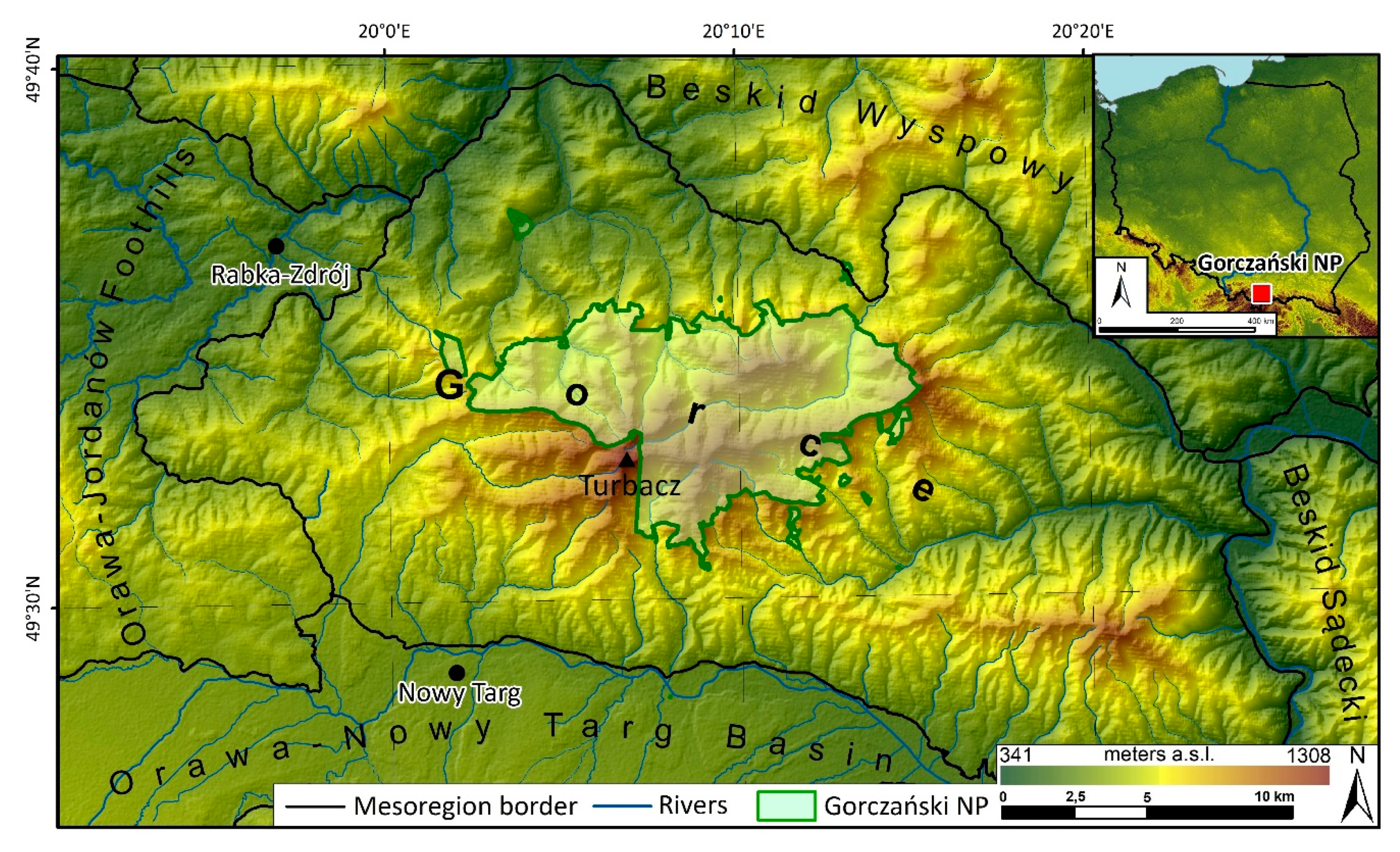

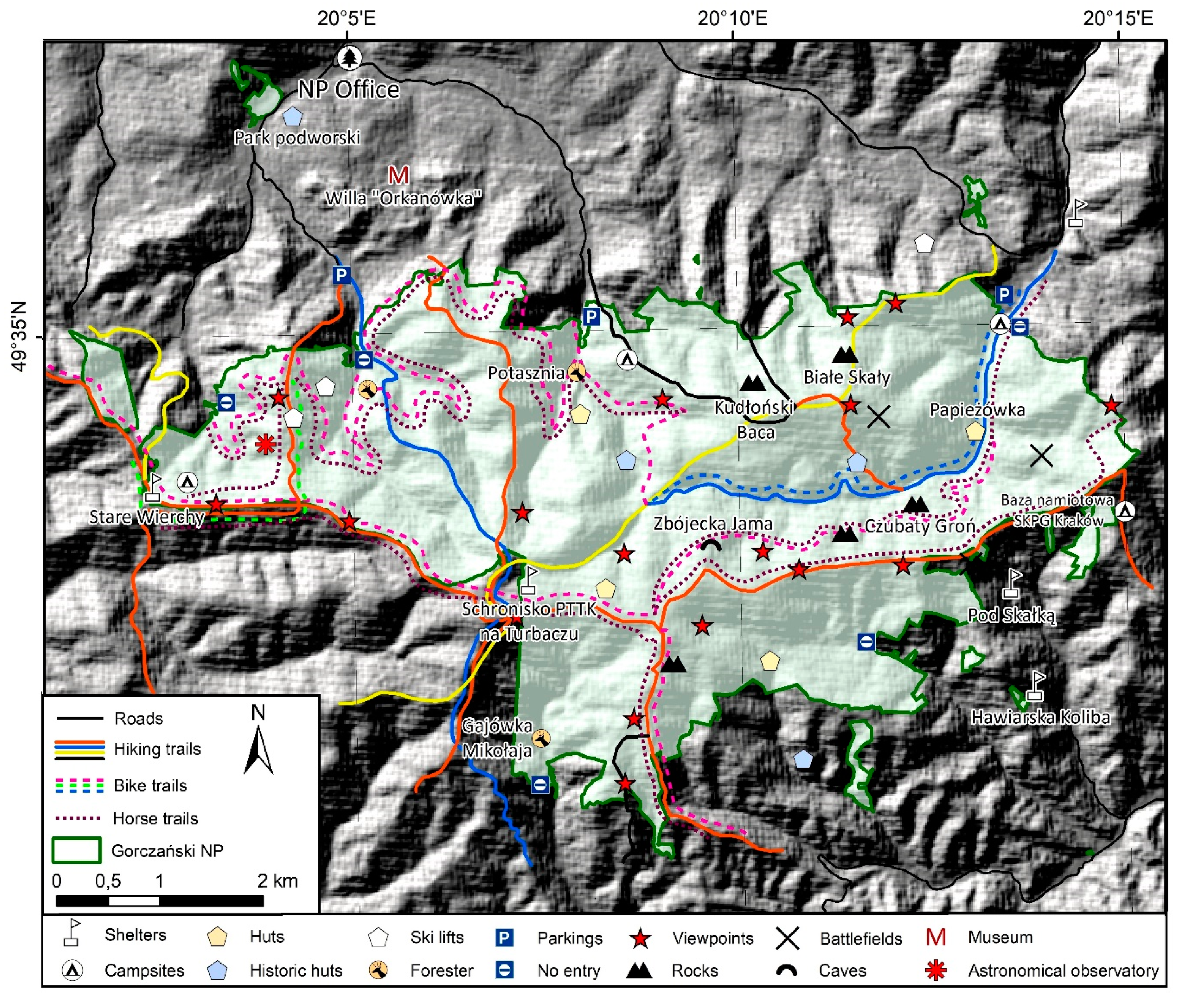
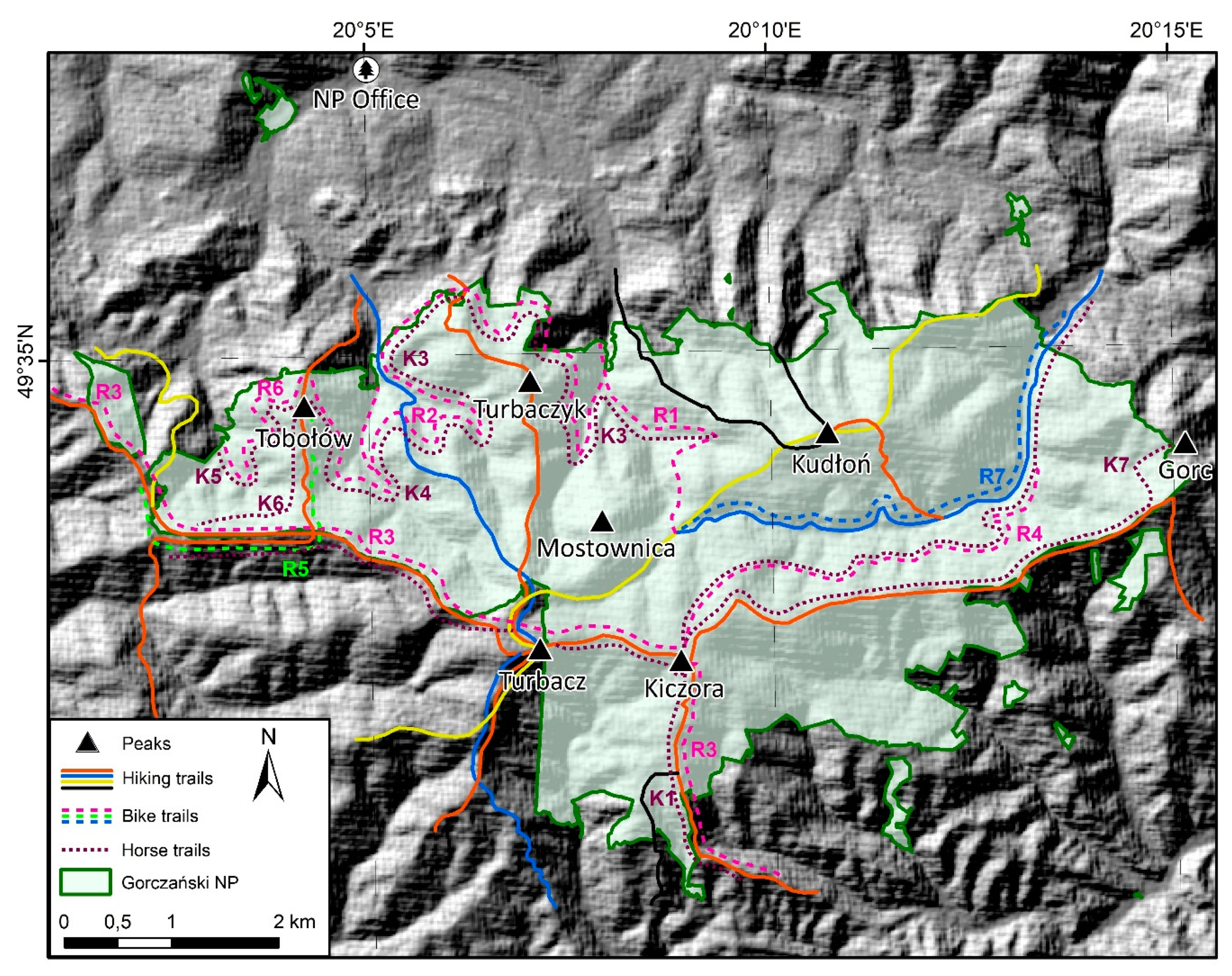
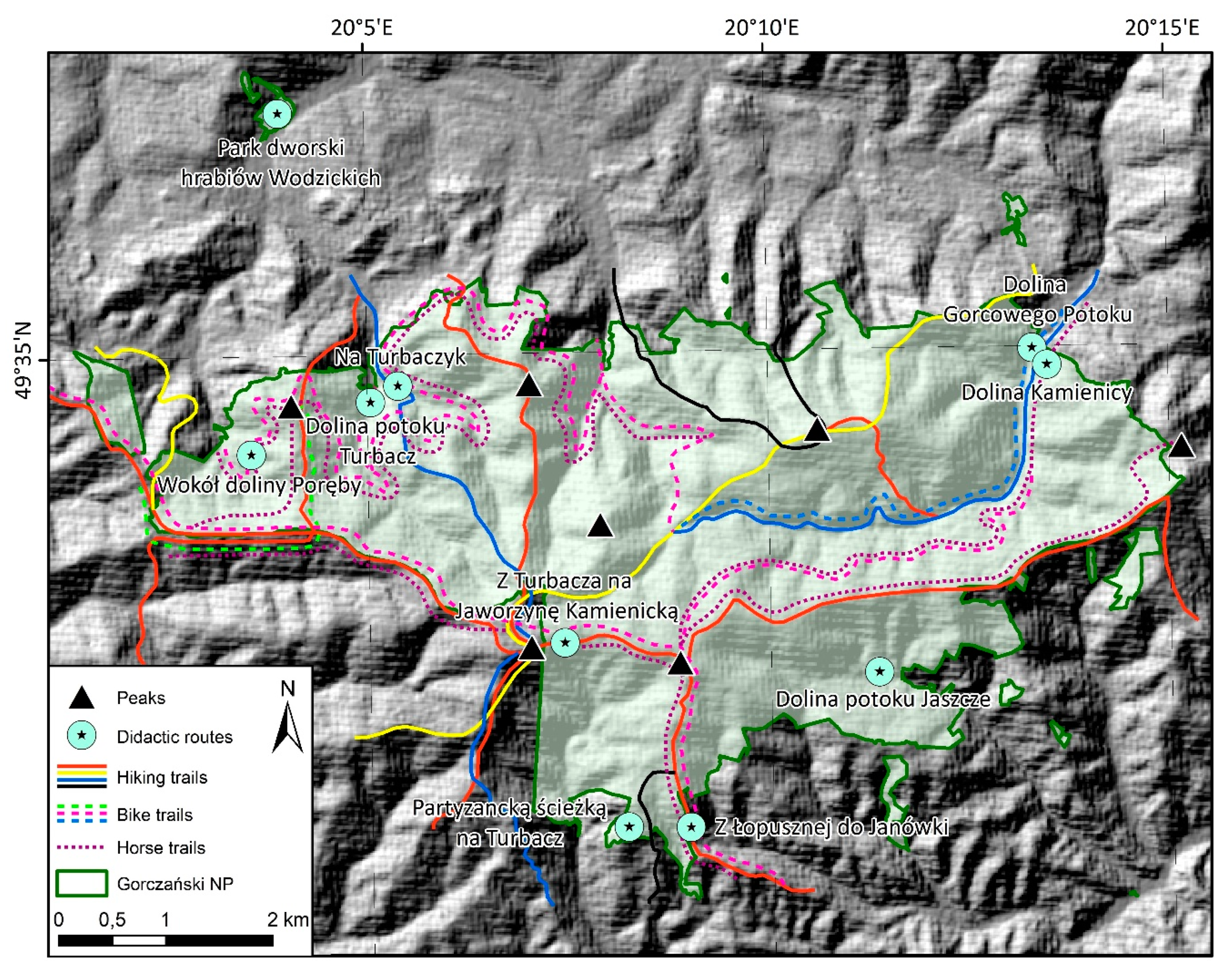


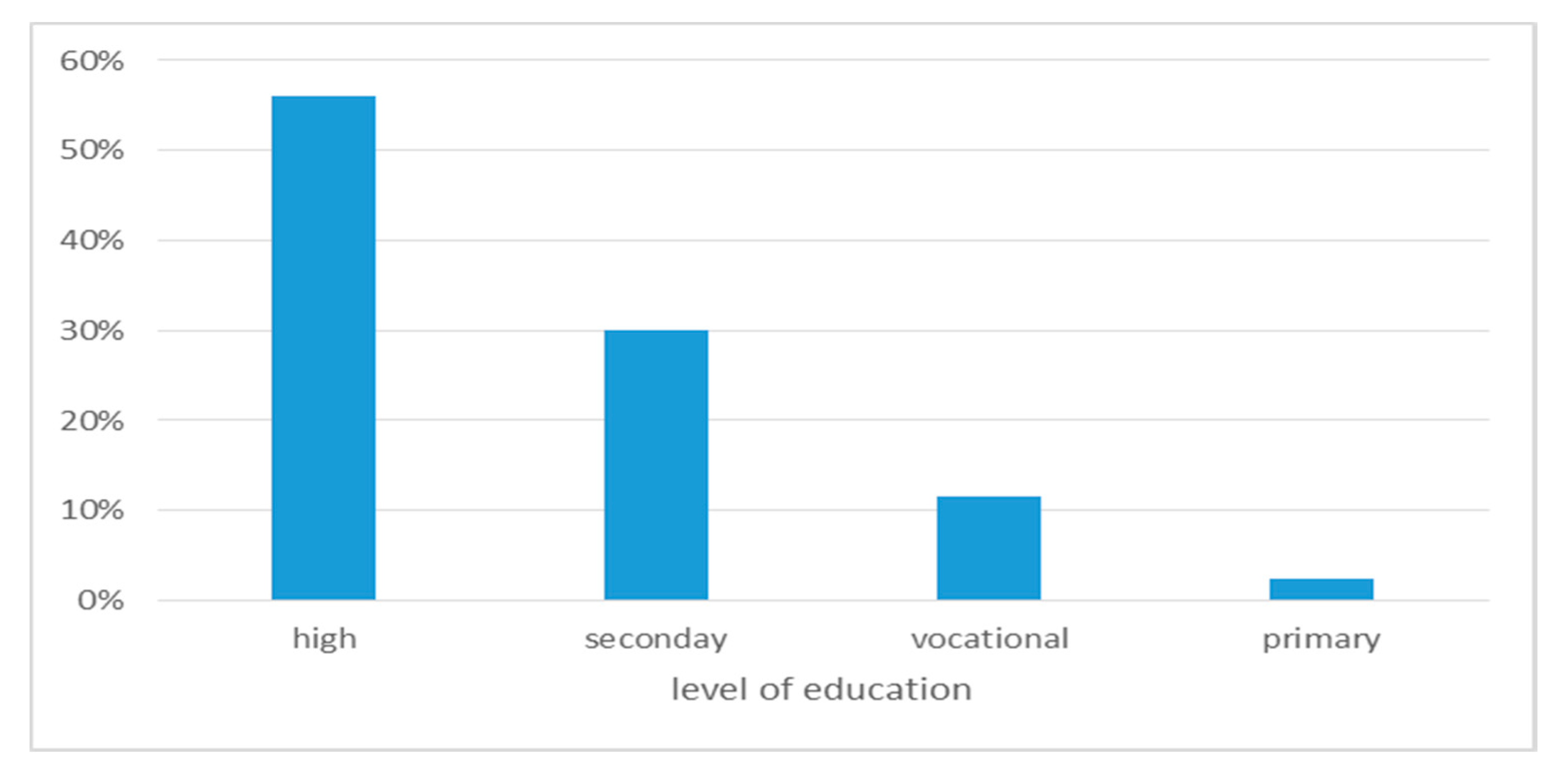
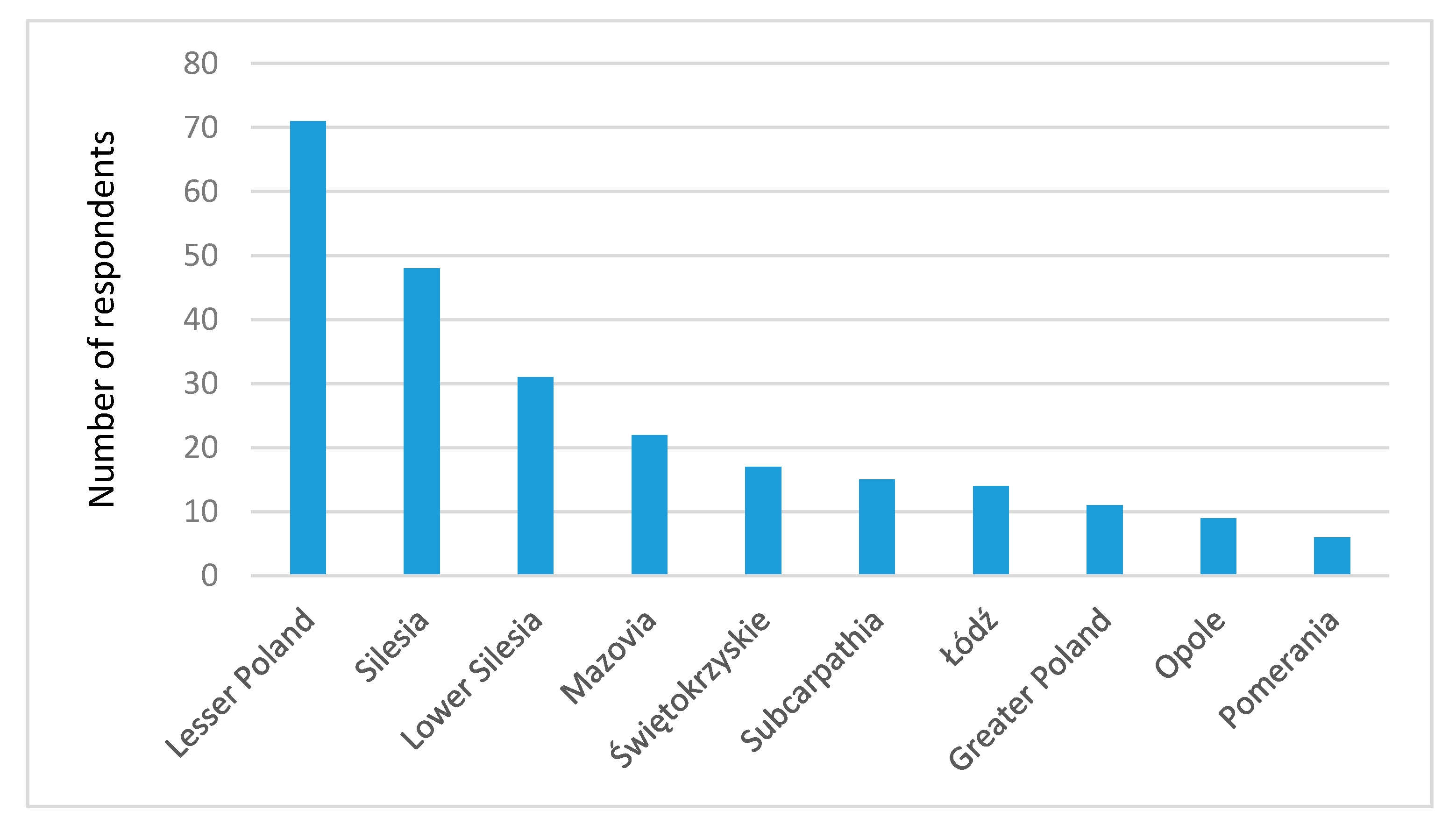

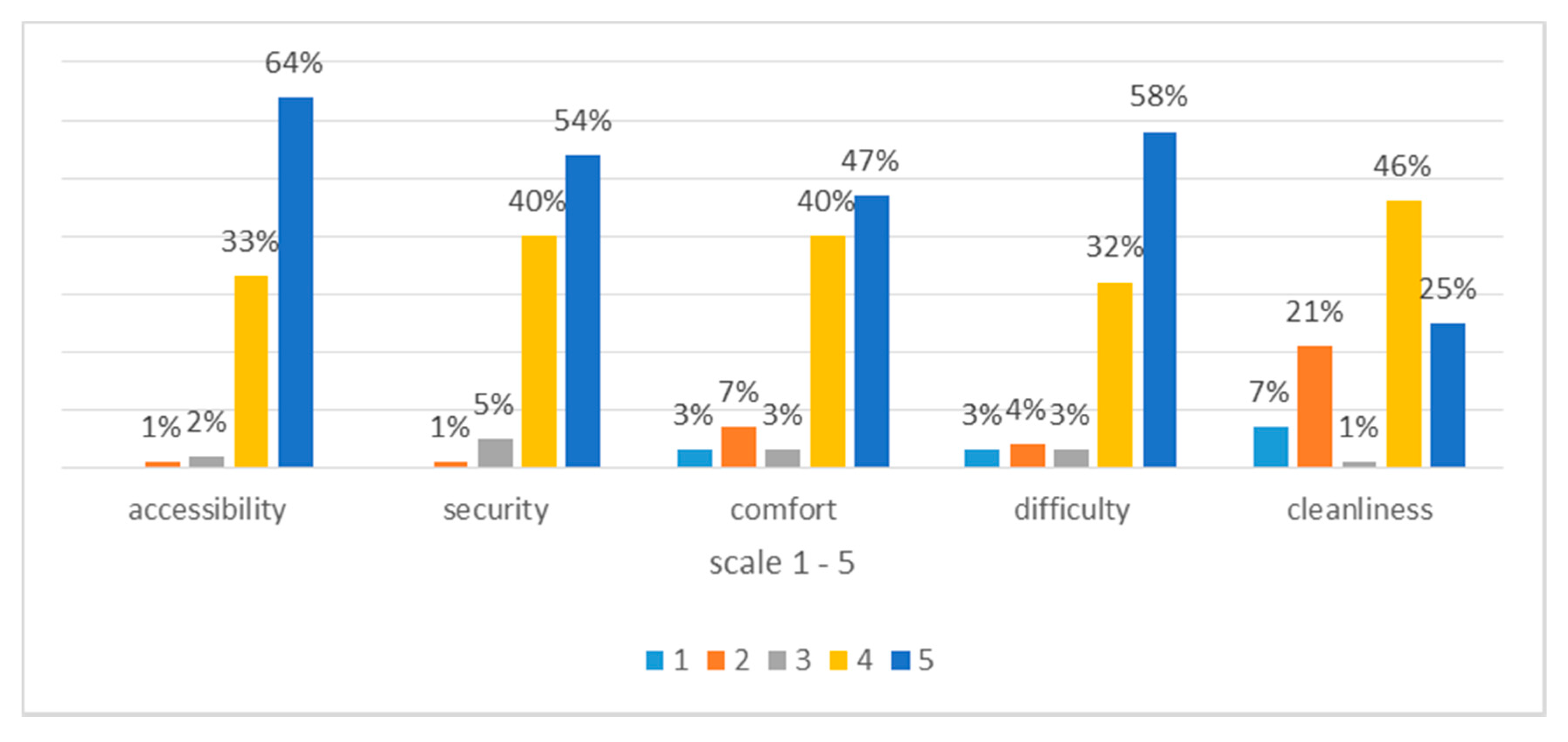
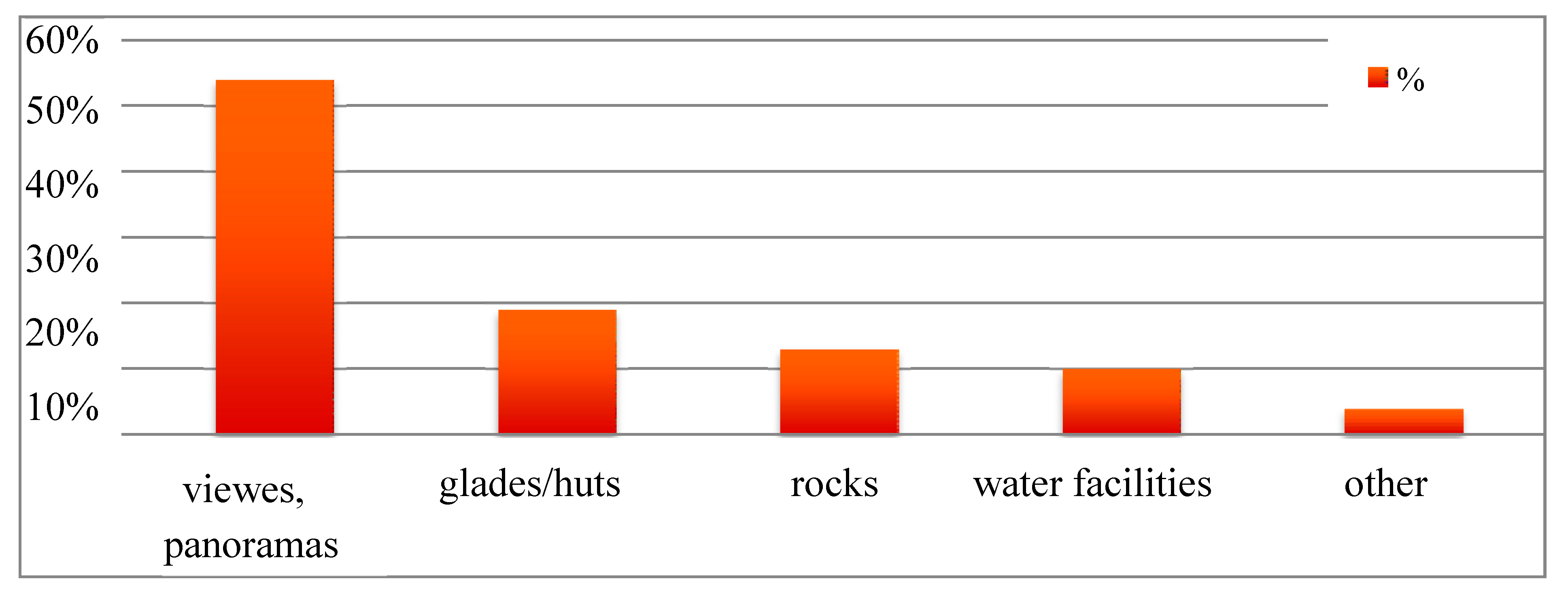
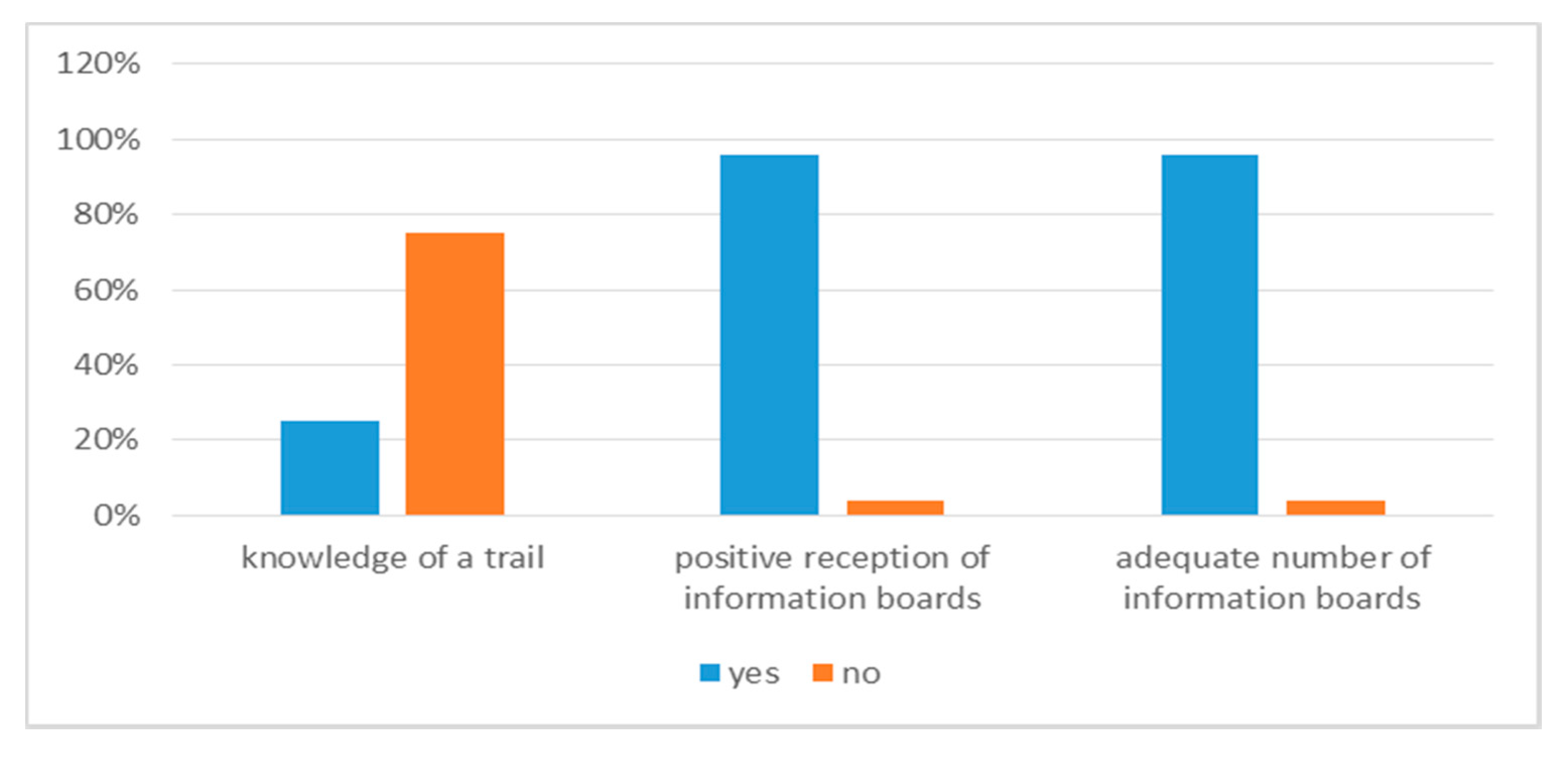
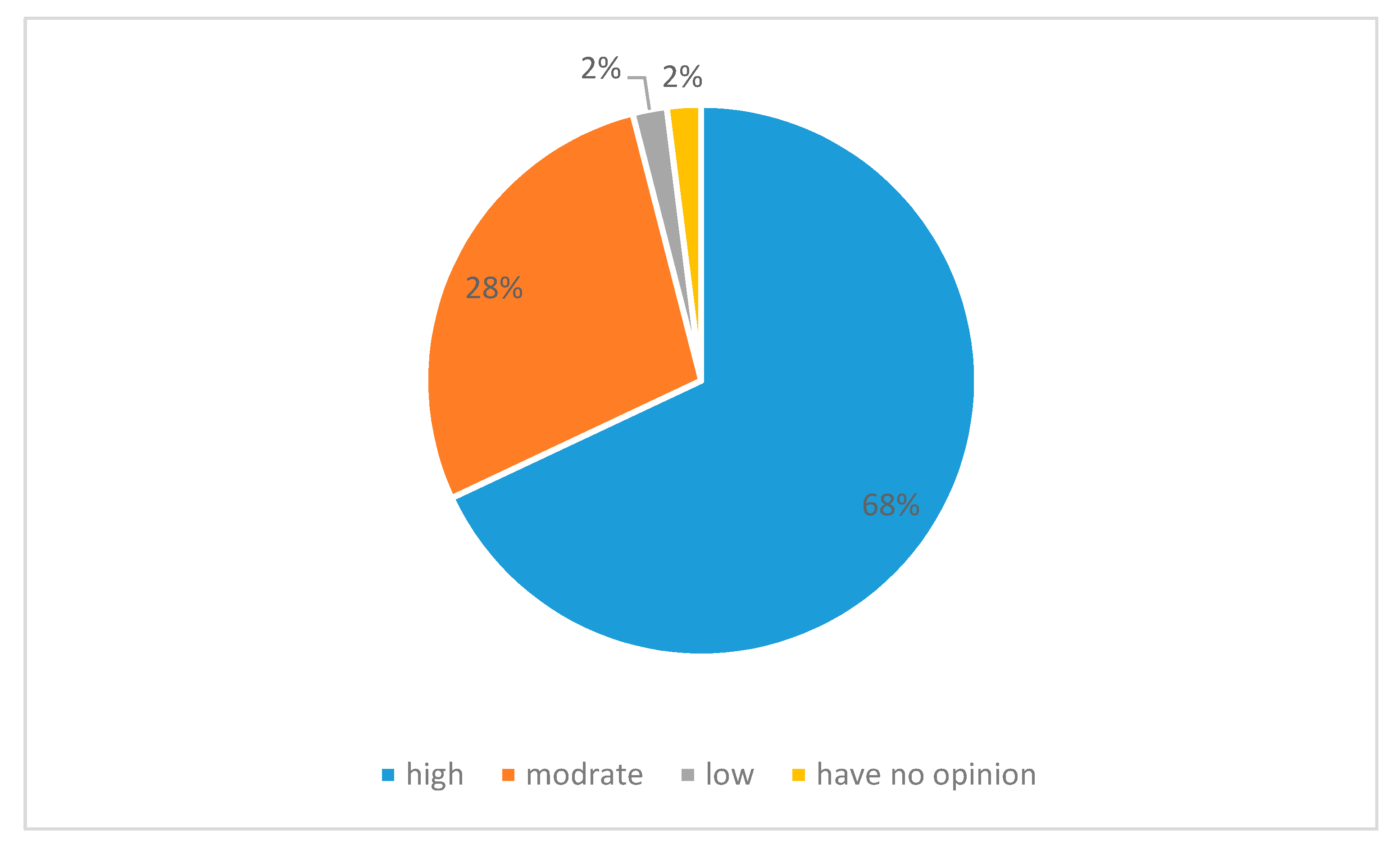
| Facility | Tourist Function |
|---|---|
| Management building | Educational and conference facilities in Poręba Wielka, conference and exhibition room for temporary exhibitions |
| Gajówka Mikołaja | The educational and exhibition base in the Łopuszna valley |
| Astronomical observatory | The highest located observatory in Poland, peak Suhory |
| The education hall in the park hut in Hala Długa | Educational activities, exhibition of the history of nature and pastoral economy in the Gorce Mts. |
| PTTK Mountain Tourism Culture Centre at Turbacz | Museum of mountain tourism history in the Gorce Mts. Surrounding area of Turbacz |
| Papieżówka shelter | The place of education classes, exhibitions; an exhibition about John Paul II |
| Shepherd’s hut | Educational classes |
| Route | Geotourist Stop |
|---|---|
| Dolina Gorcowego Potoku | Geomorphology of mountain brooks |
| Dolina Kamienicy | Geological exposure, rock |
| Dolina potoku Jaszcze | |
| Dolina potoku Turbacz | Geological structure, soil, geomorphology of the mountain brook |
| Na Turbaczyk | |
| Park dworski hrabiów Wodzickich and Chabówka | Geological structure: tectonic window |
| Wokół doliny Poręby | |
| Z Łopusznej na Jankówki | The rock outcrop underneath Wysznia |
| Z Turbacza na Jaworzynę Kamienicką | Torfowisko wysokie. Trzy Kopce |
| Partyzancką ścieżką na Turbacz | Mountain brook |
© 2020 by the authors. Licensee MDPI, Basel, Switzerland. This article is an open access article distributed under the terms and conditions of the Creative Commons Attribution (CC BY) license (http://creativecommons.org/licenses/by/4.0/).
Share and Cite
Widawski, K.; Oleśniewicz, P.; Rozenkiewicz, A.; Zaręba, A.; Jandová, S. Protected Areas: Geotourist Attractiveness for Weekend Tourists Based on the Example of Gorczański National Park in Poland. Resources 2020, 9, 35. https://doi.org/10.3390/resources9040035
Widawski K, Oleśniewicz P, Rozenkiewicz A, Zaręba A, Jandová S. Protected Areas: Geotourist Attractiveness for Weekend Tourists Based on the Example of Gorczański National Park in Poland. Resources. 2020; 9(4):35. https://doi.org/10.3390/resources9040035
Chicago/Turabian StyleWidawski, Krzysztof, Piotr Oleśniewicz, Agnieszka Rozenkiewicz, Anna Zaręba, and Soňa Jandová. 2020. "Protected Areas: Geotourist Attractiveness for Weekend Tourists Based on the Example of Gorczański National Park in Poland" Resources 9, no. 4: 35. https://doi.org/10.3390/resources9040035
APA StyleWidawski, K., Oleśniewicz, P., Rozenkiewicz, A., Zaręba, A., & Jandová, S. (2020). Protected Areas: Geotourist Attractiveness for Weekend Tourists Based on the Example of Gorczański National Park in Poland. Resources, 9(4), 35. https://doi.org/10.3390/resources9040035






